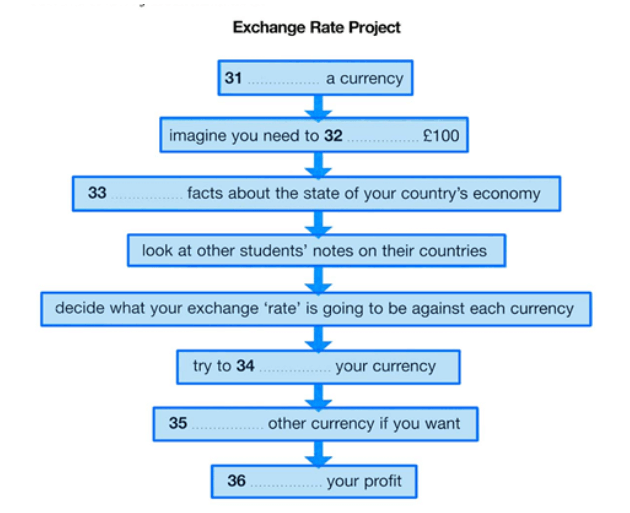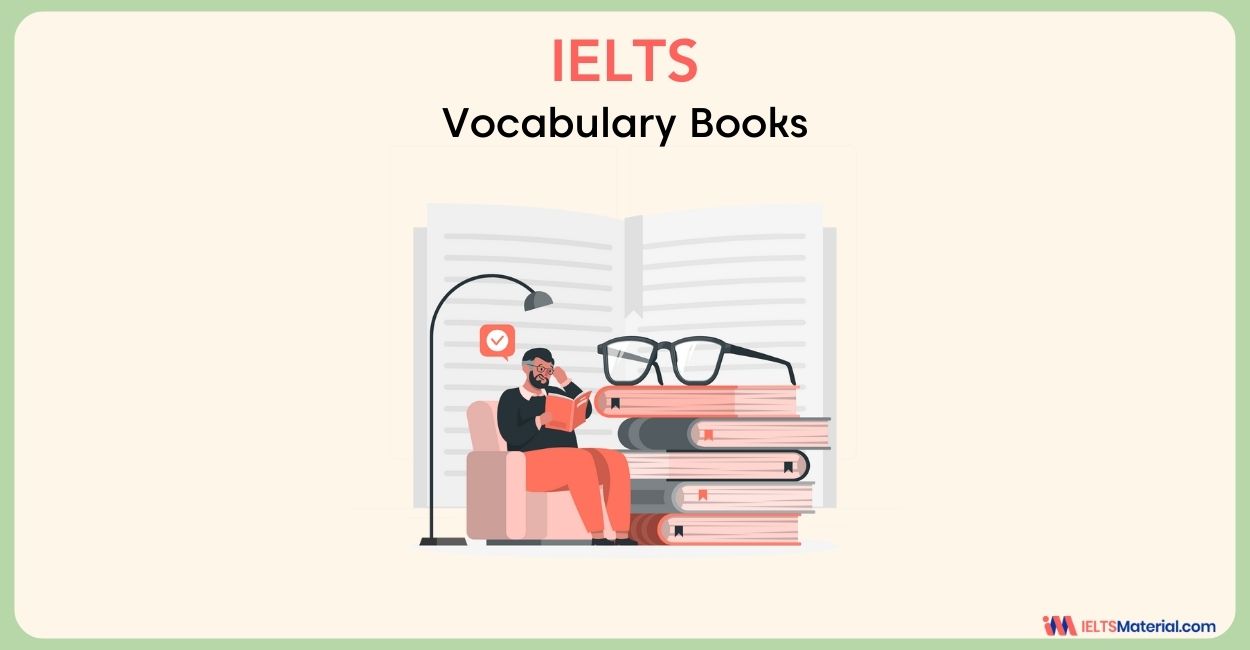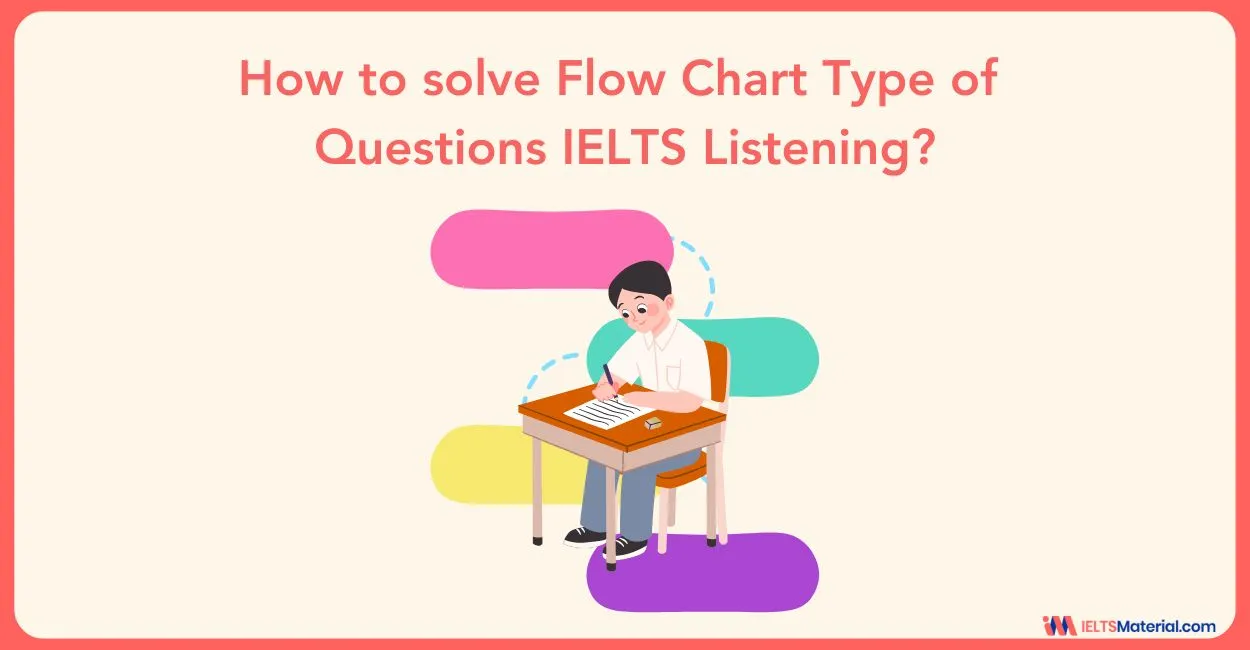IELTS Listening Flow Chart Questions: Tips, Strategies and Practice Tests
7 min read
Updated On
-
Copy link
IELTS Listening Flow Chart completion questions usually appear in section 2 & 4 of the IELTS Listening exam. Find out how to solve the IELTS listening flow chart completion exercises effectively here and boost your IELTS Listening band score.
Table of Contents

Limited-Time Offer : Access a FREE 10-Day IELTS Study Plan!
In IELTS Listening, you will come across different types of completion, like IELTS Listening sentence completion and one of them is IELTS Listening flow chart completion. They can be tricky if you are not acquainted with them during your preparation. However, with the right approach, these types of questions can become quite easy to solve!
In this blog, we’ll dive into detailed strategies and tips to solve IELTS Listening flow chart questions, along with some practice tests.
What is IELTS Listening Flow Chart Completion?
A flow chart question in IELTS exam is a form of question with a series of steps (in sequential order) and is widely used to represent the flow of algorithms, workflow or processes. Typically, a flowchart shows the order by connecting the sentences with arrows, which may be in horizontal or vertical directions.
In the listening module, there will be gaps in the flowchart and you will have to complete the flow chart by adding the missing words from each stage. They are designed to test your ability to understand the sequence of events or steps in a process. There will be flow charts that cover a wide range of subjects, but they will always consist of several phases with a starting point and a finishing point.
Example of an IELTS Listening Flow Chart Question
Now that you have an idea of what an IELTS Listening flow chart completion is all about, it is time to check out how it looks to make the identification easier.

How to Solve Flow Chart Type of Questions in IELTS Listening?
In IELTS Listening, you will hear a conversation that is always connected or has a flow of information. In the conversation, the first speaker will begin by introducing himself/herself and the subject or purpose of the talk. This will help you to understand the context and give more detail about the subject.
As you listen to the conversation, connect the dots mentally according to the questions and note the correct answer which is relatable to the question. Remember that if the answer is irrelevant, it may impact the remaining answers as well. Also, listen to the audio clip carefully as the answers will be in the sequence and the audio will be played only once.
To know the steps of how to solve flow chart type of questions in IELTS Listening, check out the video below!
Strategies to Answer Flow Chart Questions in IELTS Listening
In the exam, you will have around 30 seconds to go through the questions. Use this time efficiently to go through the flow chart completion questions. Here are the essential strategies to help you ace flow chart questions in IELTS Listening and achieve your desired IELTS band score:
- Carefully read the instructions to understand the word limit for each answer. Exceeding the limit will result in an incorrect answer, even if it is logically correct.
- The next step is to understand the structure of the flow chart. They typically have several steps or stages, each with a corresponding blank space where you need to write the correct information.
- The listening passage may not always use the same words as in the flow chart, so paying attention to keywords is crucial. Identifying and underlining keywords or key details in the questions will help to recognize the correct answer during the listening.
- Do not expect the exact words from the recording—be prepared for synonyms, paraphrasing, phrases, and idioms. For example, if the flow chart asks for ‘Fill out the application form’, the speaker might say ‘complete the application form’, or 'submit the form’. To improve this skill, work on your IELTS vocabulary.
- Analyze the flow chart before listening and try predicting answers with prepositions and content clues. Are they asking for a number, a place, a name, or an action? This will help you find the possible answers that fit the blanks.
- Flow chart questions focus heavily on sequence. The events or steps must be completed in a specific order, and the information in the recording will follow this sequence. So, listen carefully for signal words such as ‘First’, ‘Next’, ‘Then’, ‘Afterward’, and ‘Finally’ to help you understand the order of the steps.
- Unlike some other question types in IELTS Listening, where you might only need to listen for general ideas, flow chart questions demand detailed information. This means you need to focus on specific steps, actions, or instructions given in the listening passage.
Tips for Answering Flow Chart Questions in IELTS Listening
Given below are some IELTS Listening tips that will help you solve the flow chart questions in IELTS Listening exam.
- Understand the relationship and flow of the information in the Flowchart.
- Do not lose your FOCUS! Listen to the audios keenly for 30 minutes.
- Number the questions to fill up the blank spaces easily.
- Check for the spellings while writing the answers.
- Make sure the spellings are correct, as incorrect spellings will lead to loss of marks.
- Avoid memorizing while listening to the audio.
- Make sure the words you write fit grammatically into the sentence.
- Do not miss out on the plural words, which will lead to wrong answers. Ensure to recognize the plural words while hearing the audio.
- Check the number of words written, spelling, and grammar before transferring them to the answer sheet.
IELTS Listening Flow Chart Completion Practice Tests
It's time to get started on the IELTS listening flow chart completion task. The key to getting the band score of your dreams is practicing IELTS Listening practice tests with flow chart questions regularly. Here are some samples for practice.
Practice Test 1
Questions 31-36
Complete the flowchart below.
Write One Word Only for each answer.
Transcript
You will hear a tutor giving some business students instructions about a finance project. You now 30 seconds to read questions 31 to 36.
Okay. Can you quieten down please? Now, today I’m going to talk to you about your assignment. We’ve been studying the effects of the exchange rate. So I’m going to give you a project to do on this. Right. Can you make some notes while I’m talking? The first thing that I’d like you to do in order to prepare this is to select where you’re interested in. I mean, which country. And therefore which currency you’re going to be operating in. Okay. Now the purpose of the project is to make money and I’m hoping some of you will make a significant amount. So I want you to suppose that you have 100 pounds that you will have to invest purely in the rises and falls of the exchange system. In other words, you’ll be trying to predict rates. This is a project that you’ll be doing together. But before you work together, you’ll have to go off and research what you need to know about the economy of that country and how well it’s doing or is expected to do in the near future. You could all make up a little information sheet with your notes on. Clearly legible. Because then I want you to get together. We can do that next week. And to go around and read about each other’s countries.
When you see how well or badly each country is doing, I want you to decide what your exchange rate is going to be against all the other currencies. After that is all sorted, what you’re going to do is go around the other students and attempt to sell your money to the others. Remember this will depend on the success of your country’s economy and the rate you fixed for your currency.
Now, you’re not allowed to just swap currencies with each other, but you may wish to buy from the other countries. But you must do a proper transaction. All the way through this, you must keep your accounts properly for each transaction. I’ll give you one week to do this and then we will set a time for the deals to finish, a bit like the stock exchange. And at that point, I will ask you to calculate how much you have made. Is that clear?
Answers:
|
Ques No |
Correct answer |
Reason |
|---|---|---|
|
31 |
Select |
This is the word from the audio which can be found in the fourth line of the transcript. |
|
32 |
Invest |
This is the word we hear in the audio and it can be found in the eighth line of the transcript. |
|
33 |
Research |
This is the correct spelling of the word which can be found in the tenth line of the transcript. |
|
34 |
Sell |
The word “Sell” is referred to in the audio which can be found in the sixteenth line of the transcript. |
|
35 |
Buy |
This is the correct spelling of the word “Buy” which can be found in the nineteenth line of the transcript. |
|
36 |
Calculate |
This word is mentioned in the audio and in the last line of the transcript . |
Practice Test 2
Assignment Plan
Decide on research question:
Is there a relationship between hours of sleep and number of dreams?
⬇
Decide on sample: Twelve students from the 25 ……………… department
⬇
Decide on methodology: Self-reporting
⬇
Decide on procedure: Answers on 26 ………………
⬇
Check ethical guidelines for working with 27 ………………
Ensure that risk is assessed and 28 ……………… is kept to a minimum
⬇
Analyse the results
Calculate the correlation and make a 29 ………………
⬇
30 ……………… the research
Answer: Assignment on Sleep and Dreams - IELTS Listening Answers
To conclude, IELTS Listening flow chart questions may seem challenging at first, but with the right approach and plenty of practice, they become much easier. So, you have to understand the structure, predict the information, and stay focused on the details to solve these questions and achieve a high listening score.
Also Check:
Explore IELTS related articles

Start Preparing for IELTS: Get Your 10-Day Study Plan Today!
Recent Articles

Nehasri Ravishenbagam

Nehasri Ravishenbagam

Haniya Yashfeen

Kasturika Samanta




Post your Comments